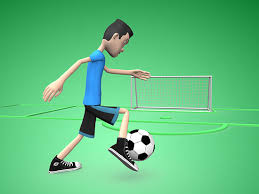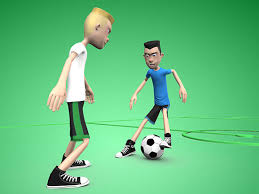 |
Footwork Drills
|
 |
Coaches and Parents, following are some simple footwork drills that your player can use as homework to improve thier basic soccer footwork.
Inside Hook Turn
(DIFFICULTY RATING: MODERATE)
This turn can feel a little awkward to do at first and is really more of a flick than a turn once done quickly. It is basically the opposite turn to the outside hook which allows the player to turn the opposite way.
Step 1 – place your standing foot directly behind the ball (lean forward and stay low)
Step 2 – your non-standing foot needs to come round and make contact with the back of the ball
Step 3 – using the inside of your foot, hook the ball behind you
Step 4 – turn (or pivot) in the same direction as the ball so you’re facing opposite direction.
TIP – this soccer moves turn is much easier to do at speed and if your ‘on-your-toes’ i.e. not flat footed.
Outside Hook Turn
(DIFFICULTY RATING: MODERATE)
The outside hook is one of my favourite soccer moves turns because it uses the outside of my foot which I feel comfortable with. Although I have put a moderate difficulty rating some young players will pick this up very easily where as others will struggle to get to grips with using the outside of their foot. We very often use the inside of our foot (passing, shooting etc) but rarely use the outside.
- Step 1 – place your standing foot besides the ball (leaving a bit more distance this time between the foot and ball than you did with the drag-back turn.)
- Step 2 – your non-standing foot will pass between the gap of the foot and ball. Young players can stand this foot down just past the ball; older players will be expected to incorporate steps 2 and 3 together.
- Step 3 – twist your standing foot so the outside of the foot is parallel with the ball (right foot would be 2 o’clock, left foot would be facing 10 o’clock.)
- Step 4 - using the outside of the foot, hook the ball in the opposite direction than your currently facing whilst keeping control
- Step 5 – turn your body in the same direction as the ball and face the opposite way.
Tip – it helps to have a low centre of gravity with knees bent and arms out whilst doing this soccer moves turn.
Cruyff Turn
(DIFFICULTY RATING: MODERATE-HARD)
The Cruyff turn (named after Johan Cruyff – former Dutch soccer player) is a stylish soccer moves turn which was used frequently in games by Cruyff. This turn is used often in the modern game due it being a moderately easy turn to master and allows the player to change direction quickly.
- Step 1 – place your standing foot next to the ball (but not too close) with your body leaning over the ball
- Step 2 – your non-standing foot needs to step over the ball without touching the ground
- Step 3 – using the inside of your foot, push the ball backwards
- Step 4 – this time (unlike the drag-back turn) your body will turn round the other way (toward standing foot) so you are facing the opposite direction
Tip – once again, this soccer moves turn becomes easier when done at speed and it is important you have good balance.
Zidane Fake
(DIFFICULTY RATING: MODERATE-HARD)
Named after one of France’s all time great soccer players, Zinedine Zidane, this move can make a defender stop and flinch, giving the dribbler time to get by his opponent.
The “fake shot” begins with just that – a fake shot. The player must make it look like he/she is going to shoot or kick it hard. The player’s body language must be convincing.
- Step 1 – Approach the ball like you’re going to kick it a long ways.
- Step 2 – As you swing your leg to kick the ball, put the sole of your foot on the top of it and roll it across your body to your other foot.
- Step 3 – Push the ball ahead, past the defender, with your other foot and continue dribbling.
Ronaldo Chop
(DIFFICULTY RATING: MODERATE-HARD)
Kids enjoy practicing this soccer move. The steps aren’t super challenging, but repeated practice is key to making the move effective.
Basic Steps:
- 1 – Jump OVER (not on) the ball.
- 2 – Land in front of the ball on one leg. For this example, let’s land on the left leg.
- 3 – Use the right leg to pass the ball behind the left leg.
Advanced Steps:
As the player gets comfortable with steps 1-3, he/she should then focus on speeding up each step.
Ideally, the player should jump over the ball and pass the ball behind his leg a split second after landing.
Finally, to further confuse the defender and disguise the move, the player should extend his arms wide like wings while jumping over the ball. This should distract the defender who will likely wonder what on earth you’re doing.
(If I can locate a decent video demonstration of this move, I’ll post it later. )
*Please instruct your players to avoid jumping ON the ball. They’ll just fall over and either get discouraged or hurt.*
Maradona Turn
(DIFFICULTY RATING: HARD)
The Maradona move in soccer is a high-skill maneuver that is named after Argentine soccer legend Diego Maradona.
- Step 1: Put your left foot on top of the soccer ball. and spin to your right
- Step 2: Drag the ball back with your right foot in a spinning motion
- Step 3: continue dribbling forward
Yo-Yo (aka Pull Back & Go)
(DIFFICULTY RATING: Easy)
Here’s a fun, quick move that players can learn easily. It can also be called a “fake reverse” or “fake pull back”.
The player begins to do a reverse, pulling the ball towards him with the sole of his foot.
Instead of completing the reverse, the player only pulls it halfway back and then quickly pushes it ahead with the same foot.
By alternating between a pull back and a yo-yo, a player can keep a defender guessing. Is he doing a reverse? Or a yo-yo?
n2LYTKRgMN8